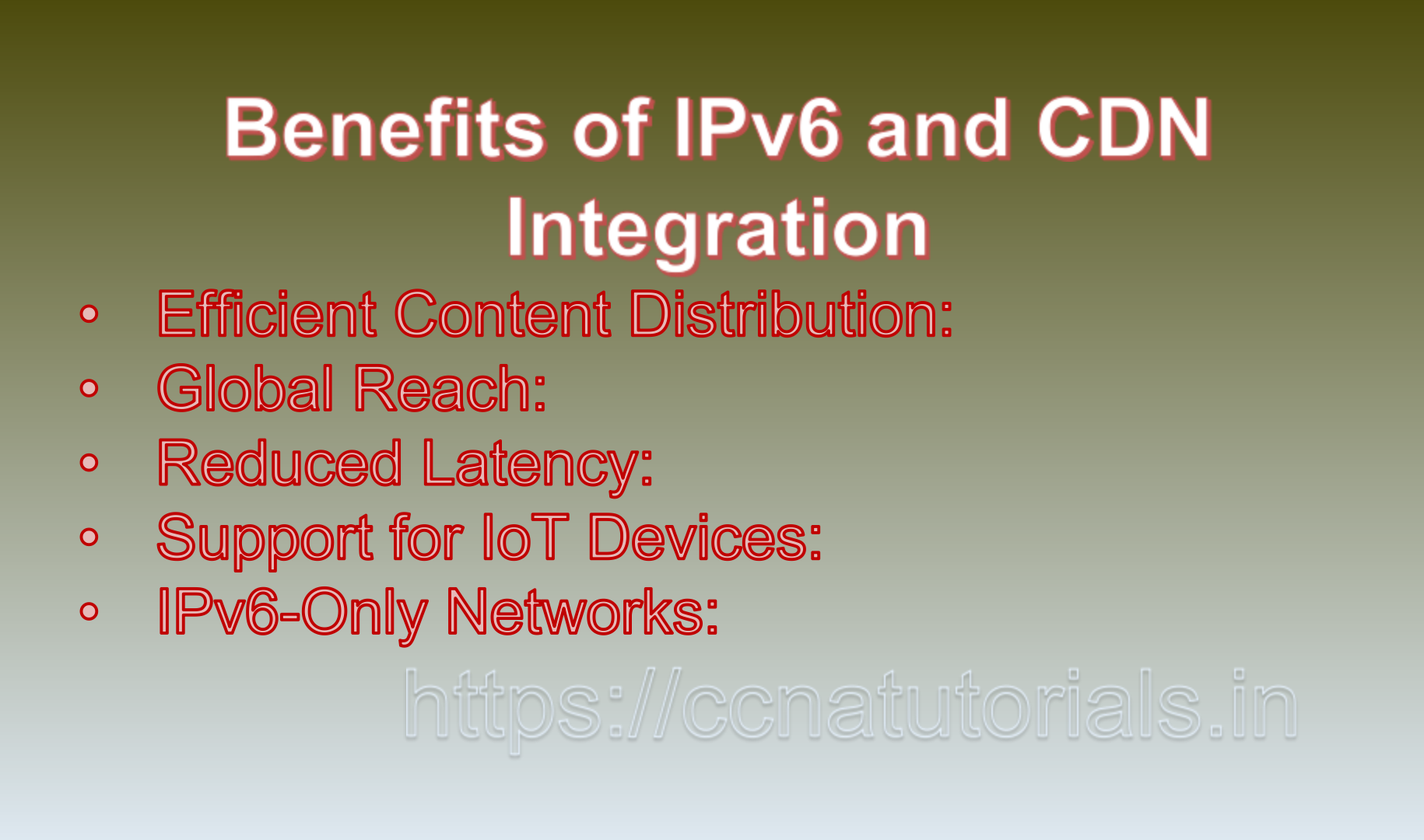Contents of this article
In this article, I describe IPv6 and Content Delivery Networks (CDNs): Enhancing Global Content Distribution. The integration of IPv6 (Internet Protocol version 6) with Content Delivery Networks (CDNs) has transformed the way content is distributed and delivered over the internet. CDNs optimize the delivery of web content by strategically placing copies of that content on servers distributed across various locations. IPv6’s features and addressing capabilities have further enhanced the effectiveness of CDNs, enabling efficient, scalable, and high-quality content distribution. In this article, we will delve into the intersection of IPv6 and CDNs, their advantages, implementation considerations, and provide examples to illustrate their importance in the modern digital landscape.
Understanding IPv6 and Content Delivery Networks: An Overview
IPv6: IPv6 is the next-generation internet protocol designed to address the limitations of IPv4. It offers a larger address space, optimized routing, and improved features to cater to the growing number of connected devices and the evolving demands of the internet.
Content Delivery Networks (CDNs): CDNs are distributed networks of servers strategically placed in various geographical locations. These servers host copies of web content, such as images, videos, scripts, and other resources. CDNs ensure faster and more reliable content delivery by serving users from the server that is geographically closest to them, reducing latency and improving the overall user experience.
Benefits of IPv6 and CDN Integration
1. Efficient Content Distribution:
IPv6’s expansive address space allows CDNs to allocate unique IP addresses to each server, streamlining content distribution and reducing the need for complex network address translation (NAT) setups.
2. Global Reach:
IPv6’s larger address pool enhances the scalability and reach of CDNs, enabling them to cater to a global user base with unique and reachable IP addresses.
3. Reduced Latency:
By using IPv6’s efficient routing, CDNs can deliver content from the nearest server, reducing the time it takes for users to access web resources and improving load times.
4. Support for IoT Devices:
IPv6’s compatibility with Internet of Things (IoT) devices aligns well with CDNs, allowing these devices to access resources through CDNs using IPv6 addresses.
5. IPv6-Only Networks:
As IPv6 adoption grows, some networks might transition to IPv6-only configurations. CDNs that support IPv6 can seamlessly deliver content to users on such networks.
IPv6 and Content Delivery Networks Implementation Considerations
1. IPv6-Enabled Servers:
CDNs need to have IPv6-enabled servers to take advantage of IPv6’s benefits. Servers must have both IPv4 and IPv6 addresses to cater to a diverse range of user connections.
2. DNS Configuration:
The DNS (Domain Name System) infrastructure must be configured to resolve both IPv4 and IPv6 addresses for CDN content, ensuring that users’ devices can access the appropriate resources.
3. Network Infrastructure:
CDNs must ensure that their network infrastructure is IPv6-ready to efficiently route traffic and optimize content delivery.
Examples Illustrating IPv6 and Content Delivery Networks Integration
1. Video Streaming Service:
Imagine a video streaming service that uses a CDN to deliver high-quality video content to users worldwide. By integrating IPv6:
– Users with IPv6-enabled devices experience faster load times and smoother playback due to efficient routing.
– Content is delivered from the closest CDN server using IPv6 addresses, minimizing latency and ensuring an optimal viewing experience.
– The CDN can seamlessly scale its infrastructure to accommodate traffic spikes and an expanding user base.
2. E-Commerce Platform:
Consider an e-commerce platform that uses a CDN to serve product images and web pages to users. With IPv6 integration:
– Users can access product pages and images quickly, resulting in a better shopping experience.
– Global customers, including those on IPv6-only networks, can access the platform’s resources efficiently.
– The platform’s servers are allocated unique IPv6 addresses, simplifying content routing and improving load times.
3. Software Distribution:
A software distribution platform relies on a CDN to deliver software updates to users. By leveraging IPv6:
– Users across the globe receive software updates from the nearest server, reducing download times and minimizing network congestion.
– IPv6 compatibility ensures that users on IPv6-enabled networks can seamlessly receive updates without compatibility issues.
– The CDN’s expanded address space supports the distribution of updates to an ever-growing number of devices.
Short description of IPv6 and Content Delivery Networks
The integration of IPv6 with Content Delivery Networks (CDNs) has revolutionized the efficiency, scalability, and reach of content distribution. IPv6’s features, including its expansive address space and efficient routing, have enhanced CDNs’ ability to deliver web content to users across the globe. By reducing latency, improving load times, and ensuring compatibility with IoT devices, IPv6 and CDNs work hand in hand to provide a seamless and optimized user experience. As the digital landscape continues to evolve, the synergy between IPv6 and CDNs will play a pivotal role in shaping the future of content delivery, ensuring that users around the world can access web resources quickly, reliably, and efficiently.

IPv6 and Content Delivery Networks (CDNs): Optimizing Global Content Distribution
The integration of IPv6 (Internet Protocol version 6) with Content Delivery Networks (CDNs) has transformed the way content is distributed and accessed over the internet. CDNs are designed to optimize the delivery of web content, such as images, videos, and scripts, by strategically placing copies of content on servers located in various geographical regions. The adoption of IPv6 enhances CDNs by enabling larger address space, improving routing efficiency, and supporting the growing demand for online content. In this article, we will explore the relationship between IPv6 and CDNs, their advantages, implementation considerations, and provide examples to illustrate their importance in modern internet content delivery.
Understanding IPv6 and Content Delivery Networks: An Overview
IPv6: IPv6 is the next generation of the Internet Protocol, designed to address the limitations of IPv4 by offering a significantly larger address space, improved routing, and enhanced features. As the number of connected devices and demand for internet services continue to grow, IPv6 ensures that there are ample unique IP addresses to accommodate this expansion.
Content Delivery Networks (CDNs): CDNs are distributed networks of servers strategically placed in various locations to store and deliver web content. By placing copies of content closer to end-users, CDNs reduce latency, improve loading times, and optimize the delivery of static and dynamic web content.
Benefits of IPv6 and CDN Integration
1. Larger Address Space:
IPv6’s expansive address space allows CDNs to assign unique IP addresses to numerous servers, facilitating the efficient distribution of content across multiple locations.
2. Global Accessibility:
CDNs with IPv6 integration offer improved global accessibility, ensuring that users worldwide can access content with reduced latency and improved performance.
3. Efficient Routing:
IPv6’s hierarchical addressing and efficient routing mechanisms enhance the ability of CDNs to route content requests to the nearest available server, minimizing network congestion.
4. Scalability:
IPv6’s abundant address space accommodates the growth of CDNs, allowing for the addition of new servers and edge locations without exhausting available addresses.
5. IPv6-Enabled Devices:
As more devices adopt IPv6, CDNs can efficiently serve content to these devices without the need for address translation mechanisms.
IPv6 and CDN Implementation Considerations
1. Server and Network Infrastructure:
CDNs need to ensure that their server and network infrastructure is IPv6-compatible to provide content to users with IPv6-enabled devices.
2. Address Allocation:
CDNs must manage IPv6 address allocation efficiently to ensure that servers have unique addresses and can be access by users globally.
3. Routing Optimization:
Leveraging IPv6’s efficient routing capabilities, CDNs can optimize content delivery by directing users to the nearest edge server for faster access.
Examples Illustrating IPv6 and CDN Integration
1. Global Media Streaming:
Imagine a video streaming service that provides high-definition content to users across the world. By integrating IPv6 with CDNs:
– Users with IPv6-enabled devices experience faster loading times and smoother playback of videos due to efficient routing and reduced latency.
– CDNs can distribute content to edge servers in multiple regions, allowing users to access content from nearby servers and reducing the load on central servers.
– IPv6 addresses accommodate the scalability requirements of the streaming service as its user base grows.
2. E-Commerce Platform:
An e-commerce platform serves customers worldwide by delivering product images, descriptions, and transactional data. With IPv6 and CDNs:
– Users with IPv6-enabled devices experience quick loading times when browsing products and making purchases.
– CDNs optimize content delivery by directing users to edge servers located near their geographical location, enhancing the overall shopping experience.
– Scalability is ensured as the platform serves a global audience, thanks to IPv6’s expansive address space.
3. News and Information Websites:
News websites deliver timely content to a diverse audience spread across different regions. By leveraging IPv6 and CDNs:
– Content, such as news articles and images, is efficiently delivered to users with IPv6-enabled devices, ensuring a seamless news reading experience.
– CDNs distribute content to edge servers, reducing the load on origin servers and improving response times during high-traffic periods.
– IPv6’s compatibility with modern devices ensures that users can access the latest news updates using a variety of devices.
Conclusion for IPv6 and Content Delivery Networks
The integration of IPv6 with Content Delivery Networks has revolutionized how web content is distributed and accessed globally. By leveraging IPv6’s expansive address space, efficient routing, and compatibility with modern devices, CDNs can optimize the delivery of web content to users, regardless of their geographical location. This integration contributes to reduced latency, improved performance, and enhanced user experiences, making it a critical component of modern internet infrastructure. As the digital landscape continues to evolve, the synergy between IPv6 and CDNs will remain instrumental in ensuring efficient and seamless content delivery to users around the world. I hope you found this article helpful, You may contact us or drop a comment below for any query related to this article.






